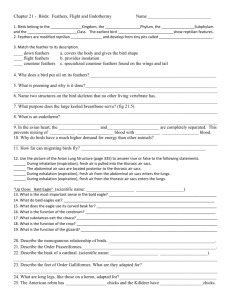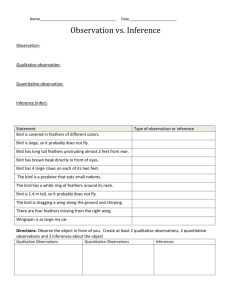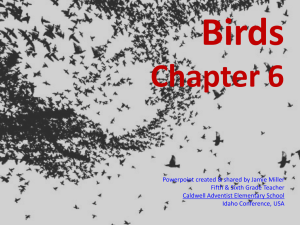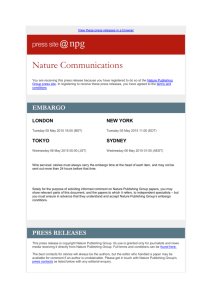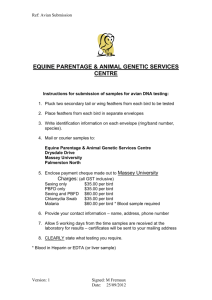Chapter 6\ part 1 Pigeon : Morphology & Digestive System Taxa
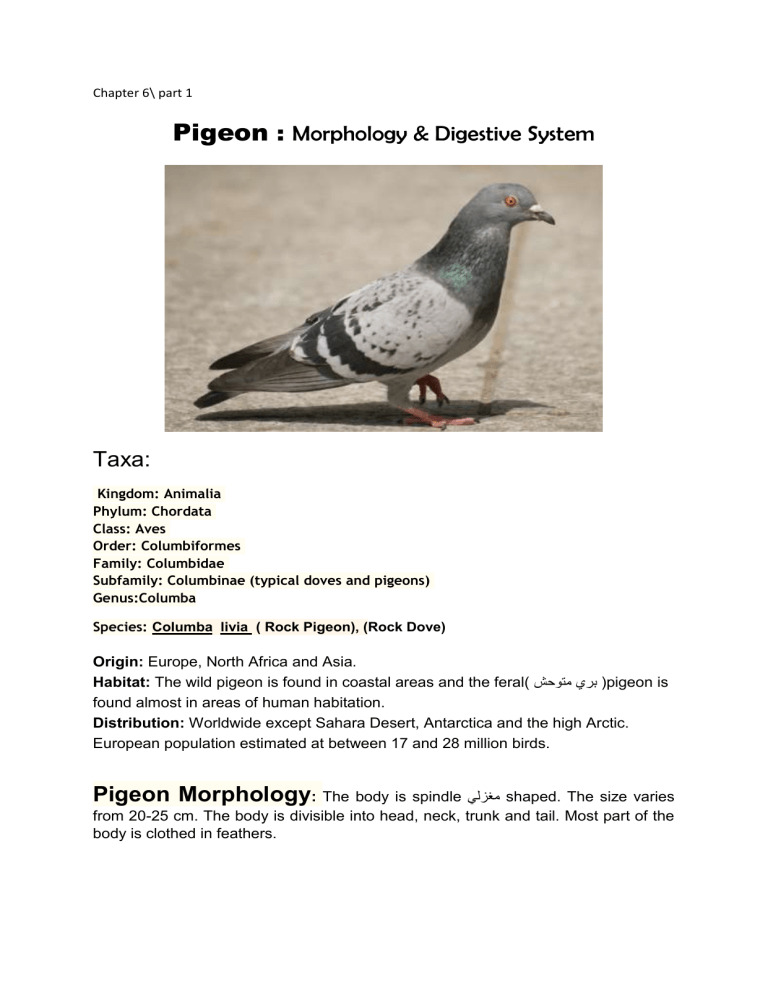
Chapter 6\ part 1
Pigeon
:
Morphology & Digestive System
Taxa:
Kingdom: Animalia
Phylum: Chordata
Class: Aves
Order: Columbiformes
Family: Columbidae
Subfamily: Columbinae (typical doves and pigeons)
Genus:Columba
Species:
Columba livia ( Rock P igeon) , ( Rock Dove)
Origin: Europe, North Africa and Asia.
Habitat: The wild pigeon is found in coastal areas and the feral( شحوتم يرب )pigeon is found almost in areas of human habitation.
Distribution: Worldwide except Sahara Desert, Antarctica and the high Arctic.
European population estimated at between 17 and 28 million birds.
Pigeon Morphology
: The body is spindle يلزغم shaped. The size varies from 20-25 cm. The body is divisible into head, neck, trunk and tail. Most part of the body is clothed in feathers.
Head:
The head is small and rounded. It is anteriorly
يمامأ pointed into a short beak. The head contains the following structure.
Mouth:
It is the wide gap ةوجف at the anterior end of the head and is bounded by upper and
lower beaks. Both the beaks are covered by a sheath دمغ called horny sheath or rhamphothecae.
Cere:
At the base of upper beak occurs a pair of whitish swollen ةخفتنم area of soft skin , called cere.
External Nares:
Just anterior to the cere, a pair of external nares are present as minute slits.
ةقيقد قوقش
Eyes:
On each lateral side a pair of eyes are present. Each eye is provided with an upper, a lower and a movable transparent third eyelid or nictitating
فارفر membrane which runs across the eyeball. نيعلا ةلقم
External Ear:
These are small holes on the posterior side of the eyes. Each hole remains covered by a special group of feathers called auricular feathers.
Neck:
The neck is long and flexible. Its flexible nature is responsible for the universal movement of the head.
Trunk:
It is the greatest and widest part of the body. It is boat shaped. At the posterior end of the trunk is the cloacal aperture. The trunk bears a pair of wings and pair of legs.
The forelimbs ةيماملاا فارطلااare modified into wings. Each wing consist of 3 parts: branchium (upper arm), antebranchium (fore arm دعاسلا) and manus (hand) with 3
fingers. Thehind limbs are adapted to balance and support the entire weight of the body at rest. Each hind limbs consists of 3 parts, Femur (thigh), crus (shank) and
(foot) with four toes. The first toe or hallux is directed backwards the remaining three forwards. The feet are adapted for sitting with long toes and curved claws. The entire foot is covered with horny epidermal scales ةنرقتم.
Tail:
The tail is a conical projection يطورخم behind the cloacal aperture. Dorsally the avian skin of tail bears an oil gland or preen gland that secrets an oil by the bird to preen its feather. It is best developed in water birds.
Exoskeletons:
The exoskeletons of birds include beak, claws, and feathers. The beak is heavily keratinized نرقتم structure. The claws are epidermal derivatives ةرشبلا ةقبط نم ةقتشم that lie on the toes. The feathers, the appendages دئاوز of avian skin, are also heavily keratinized. The keratin of avian skin is α-keratin . The feathers are evolved from the epidermal scales of reptilian ancestors فح اوزلا فلاسا . The feathers contain β-keratin which is the same type of keratin that occurs in the outer surface of scales of reptilian ancestors. The arrangement of feathers on the body is called pterylosis .
The feathers are arranged in definite tracts or areas. These tracts are separated by feathersless area called apteria. The feathers are of 3 types: quill feathers, contour feathers and filoplumes.
Quill Feathers:
The Quill feathers are located on the wings that help in flight are called reminges or wing quill and those are present on the tail (12 in number in pigeon).
Contour Feathers:
Most familiar and complex are the contour feathers. They are located all over the body except at the wings and tail. They give the bird its external form(contour) and provide airfoils for the flight.
Filoplume or Hair Feathers :
These are present along the contour feathers.
Down Feathers:
In nestlings (young birds in the nest) down feathers are present as temporary covering. In some species down feathers are hidden by contour feathers, are widely distributed and not restricted to pterylae. Their function is insulation.
Pigeon Digestive System:
The digestive system of the bird begins with the beak and tongue. Evolution has eliminated the teeth in birds. Birds have a very strong beak. The beak and the tongue are modified according to the diet and the environment of the bird. When a bird eats, it uses its beak and tongue to gather food. Since a bird has no teeth, chewing time is eliminated. Since a bird does not have to chew its food they can often eat a large quantity of food at one time. Saliva lubricates the food much like in a human so that it can pass to the esophagus
ئرم. The esophagus is a tube-like structure which passes food in waves better, to an organ known as the crop ةلصوح.
A crop's main function is to store food. It is like an extra fuel tank for the bird. The crop is located at the base of the neck and can be easily seen after a bird has just eaten. If the crop is large in size the bird is probably full. If the crop is deflated and has a flat appearance the bird has not eaten yet. The crop continuously supplies small amounts of the food to the stomach.
The food passes from the crop to the stomach, the most active part of the digestive system of a bird. There are two parts to the stomach of a bird. The first part is known as the proventriculus.
This is the glandular portion
يدغ ءزج of the stomach. This portion secretesdigestive juices which break down the food. The proventriculus joins a large muscular portion of the stomach known as the ventriculus, or more commonly known as the gizzard .
The gizzard grinds up food even more. The gizzard contains gravel
ىصح, or girt, which works alongside with muscles in grinding up food. Some birds have gizzards
that are so powerful they could grind up needles of steel in a matter of hours. In birds that ingest whole seeds a gizzard is very important. In these birds digestive enzymes alone cannot effectively break the seed hull. This is where the gizzard comes in to help. These birds require a large amount of grit in their diet.
After leaving the gizzard the food is passed on to the small intestine where it mixes with bile and enzymes. The enzymes help with the breakdown of sugars, fats and proteins. Bile from the liver breaks down the larger fat molecules. The nutrients are then absorbed and passed on to the blood stream.
The liver of the bird has two equal lobes صوصف and is nestled next to the heart under the rib cage يردصلا صفقلا . Like in humans, the liver acts for purifying toxins that enter the bloodstream and it recycles red blood cells.
The pancreas in birds is located near the small intestine. The first function of the pancreas is to neutralize ليدعت acids that are found in the mixture passed on from the stomach. If this does not occur serious damage could occur to the intestine of the bird. Another major function of the pancreas is to produce insulin so that all the bird's cells are supplied with glucose.
The waste is excreted in the form of bird droppings ثور. Birds tend to make droppings often because they have such a high metabolism and eat often. If your bird is a seed eater its droppings should have a firm greenish or brown part, this is the feces , and the dropping should have a white pasty نيل part, this is the urine.
There are several reasons why a bird can have loose droppings.
A bird's digestive system is extremely efficient because it has to be to keep up with the metabolic reactions the bird has. Birds that are fruit eaters can digest berries in thirty minutes, and seed eaters usually digest their food within three hours.


